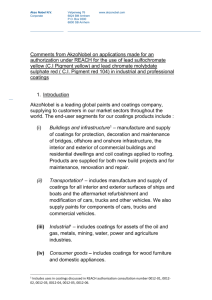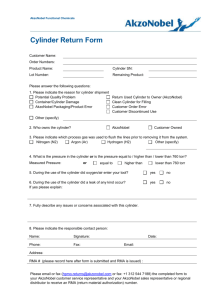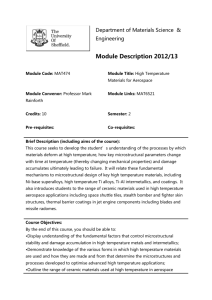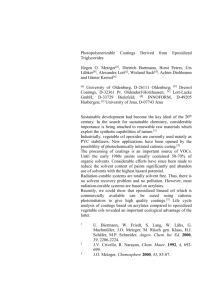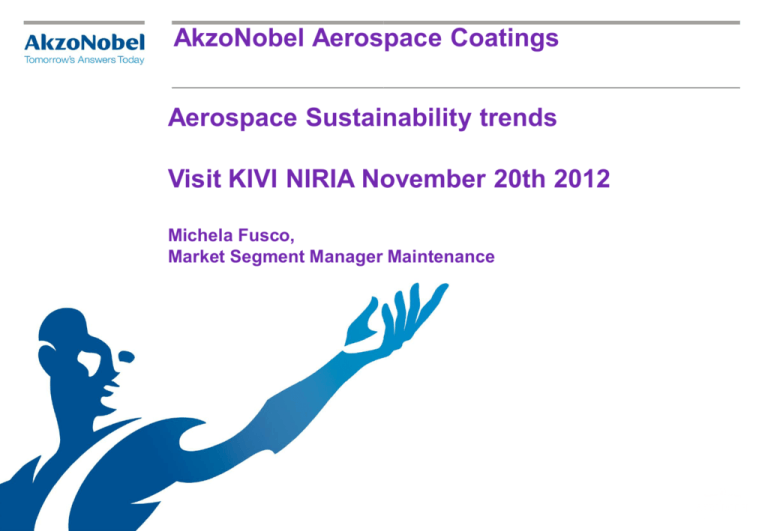
AkzoNobel Aerospace Coatings
Aerospace Sustainability trends
Visit KIVI NIRIA November 20th 2012
Michela Fusco,
Market Segment Manager Maintenance
Aerospace Coatings
• Global market size is €250
250
million¹
• External and internal coatings
for commercial, general aviation
and military markets for both
OEM application and
maintenance and repair
• Market strongly driven by
commercial sectors (airlines),
both in new building and
maintenance (livery changes)
• Complex manufacturer
specifications.
¹ External sources and company estimates
© 2012 AkzoNobel NV. All rights reserved.
Aerospace Coatings | Introduction to AkzoNobel
2
Aerospace Coatings Market Segments
Maintenance
(MRO)
OEM Endline
Air Defense
Military
Ground
Equipment
© 2012 AkzoNobel NV. All rights reserved.
ANAC
Market
Segments
Cabin
Coating
General
Aviation
OEM
Structural
Aerospace Coatings | Introduction to AkzoNobel
3
© 2012 AkzoNobel NV. All rights reserved.
Aerospace Coatings | Introduction to AkzoNobel
4
Why new developments?
developments
Legislation/
eco-efficiency:
•Toxicity
•Energy use
•Material use
•Emissions and waste
•Extended durability
•Hazard potential
New developments
Customer:
• Faster cure
• Low temperature cure
• Solvent emission reduction
• Less toxic ingredients
• Extend durability
• Reduced dry film weight
• High coverage
• Consistent quality
• Easy stripable systems
© 2012 AkzoNobel NV. All rights reserved.
• Image / aestethics
• Ease of application
• Easy maintenance
• Low process cost
• Extended durability
• New specifications
Aerospace Coatings | New Developments
5
Main drivers in Aerospace sustainable
developments
• Extended durability (lower
lower
emission, waste, maintenance
costs);
• Base coat clearcoats
• Solvent emission reduction
• Low VOC and zero VOC
• Less toxic ingredients
• Chrome-free developments
• Lower fuel consumption
• Low drag project
• Reduction of weight
© 2012 AkzoNobel NV. All rights reserved.
Aerospace Coatings | Introduction to AkzoNobel
6
Low VOC and zero VOC
Focus on products for Defense segment:
• National qualification bodies driving enforcement of
environmentally friendly products
•Appearance
Appearance key requirement of Commercial aviation.
© 2012 AkzoNobel NV. All rights reserved.
Aerospace Coatings | Introduction to AkzoNobel
7
Chrome Free Developments
New HS and WB Chrome Free Developments
The new technology provides improved corrosion protection
compared to state of the art Chrome free Technology
Fast and Effective passivation of damaged area
Leaching technology
Ra= 573 nm
Chromated
Ra= 403 nm
Chromated
New CF technology
Previous Generation CF
Ra= 1.75 µm
Previous CF technology
Generation of Passivation layer
© 2012 AkzoNobel NV. All rights reserved.
Aerospace Coatings | New Developments
8
Chrome Free Developments
New HS and WB Chrome Free Developments
New Chrome free Technology provides
active filiform corrosion inhibition.
This results in:
Previous CF Technology
New CF Technology
Chromated
Filiform corrosion development (EN3665)
• Low corrosion rate
(2024 T3 Unclad TSA)
max. length filament (mm)
6
• Shorter filaments
• Low corrosion area
5
4
3
2
1
0
0
500
1000
1500
2000
Time (h)
Previous CF technology
2000 h Filiform 2024 T3 Clad – Sol gel
New CF technology
chromate
Filiform corrosion development (EN3665)
(2024 T3 Clad- Solgel)
Max. length filiform (mm)
6
5
4
3
2
1
0
0
200
400
600
800
1000
Time(h)
Chromate
New Technology
© 2012 AkzoNobel NV. All rights reserved.
Previous CF Technology
New CF Technology
Chromate
Aerospace Coatings | New Developments
9
Chrome free developments
Aerodur® 2100 MgRP
Development time line:
ANAC - North Dakota State University
collaboration on magnesium rich primer
technologies
MgRP formula “locked”
Proof of concept established,
technology license and joint
development program established
Submitted for evaluation,
qualification and field
testing
Coatings development in
ANAC, with testing and
assistance through CTIO
and AFRL
Final stage of
qualification
MILPRF-32239
MIL-PRF-23377
2004
2005
2009
Present
New Protection mechanism for Aerospace applications:
Aerodur®
® MgRP primers used as a system with appropriate
pretreatments and topcoats provide a fully chromate-free
chromate
system
which exceeds the corrosion capabilities of commercial and
military standard products.
© 2012 AkzoNobel NV. All rights reserved.
Aerospace Coatings | New Developments
10
Chrome free developments
Aerodur® 2100 MgRP
Technology based on Magnesium
metal particles as corrosion inhibitor
in a 2 K epoxy system
The anti-corrosive
corrosive properties
of this coatings is mainly based on a
galvanic protection mechanism
Cathodic protection
provided by Mg metal powder
Analogous to Zn rich primers for
steel
Secondary effects:
Barrier protection
Leaching
© 2012 AkzoNobel NV. All rights reserved.
100µm
High PVC of sacrificial
metal provide electrical
conductivity between Mg
particles and the substrate
Aerospace Coatings | New Developments
11
Magnesium Rich Primer Technology
Neutral Salt Spray (ASTM B-117)
B
Traditional Chromate System versus Chromate Free System on
2024-T3,
T3, 3000 hours of NSS ASTM-117
ASTM
© 2012 AkzoNobel NV. All rights reserved.
12
Reduce Aicraft fuel consumption by surface
drag reduction
4555
4555
drag by
surface
other sources
© 2012 AkzoNobel NV. All rights reserved.
AkzoNobel 2012
Aerospace Coatings |
13
Reduction of Aircraft fuel consumption by
applying a micro structured surface
Current aircraft surfaces have some turbulent airflow along
•Current
the skin.
•Riblets will guide the airflow along the skin, which leads to
reduced skin friction.
The idea originates from an example from nature.
Airbus Operation and Fraunhofer
IFAM are taking part in Clean Sky
Joint technology initiative
AkzoNobel A&AC develops a
demanding commercial clearcoat for
the process
© 2012 AkzoNobel NV. All rights reserved.
Aerospace Coatings | Introduction to AkzoNobel
14
Riblet structure
© 2012 AkzoNobel NV. All rights reserved.
Aerospace Coatings | Introduction to AkzoNobel
15
Principle of riblet coating application
© 2012 AkzoNobel NV. All rights reserved.
Aerospace Coatings | Introduction to AkzoNobel
16
Coatings requirement and sustainability
performance
•Aerospace Clearcoat properties like
Flexibility
Chemical resistance
Durability
•No VOC, current clearcoat has VOC 480 g/l
•Reduction
Reduction of drag between 6-10%
6
resulting in fuel
savings of 1-2%
•Transfer
Transfer efficiency around 100%
Clean process (no overspray, no cleaning of hangar
etc)
© 2012 AkzoNobel NV. All rights reserved.
Aerospace Coatings | Introduction to AkzoNobel
17
The process
© 2012 AkzoNobel NV. All rights reserved.
Aerospace Coatings | Introduction to AkzoNobel
18
Riblet application at IFAM
© 2012 AkzoNobel NV. All rights reserved.
AkzoNobel 2012
Aerospace Coatings |
19
Thanks for your attention!
© 2012 AkzoNobel NV. All rights reserved.
Aerospace Coatings | Aerodur® 3001 & 3002
20

